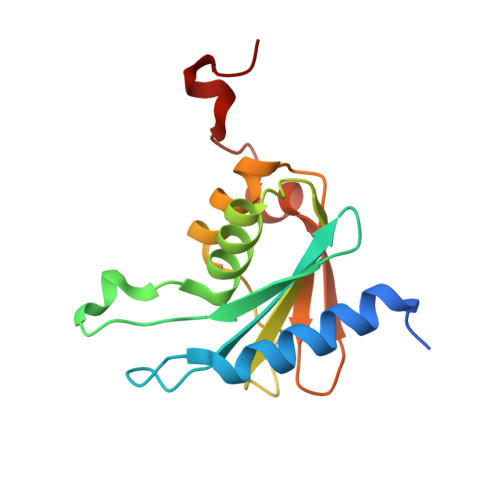The 1.48 A Resolution Crystal Structure of the Homotetrameric Cytidine Deaminase from Mouse
Teh, A.H., Kimura, M., Yamamoto, M., Tanaka, N., Yamaguchi, I., Kumasaka, T.(2006) Biochemistry 45: 7825-7833
- PubMed: 16784234
- DOI: https://doi.org/10.1021/bi060345f
- Primary Citation of Related Structures:
1ZAB, 2FR5, 2FR6 - PubMed Abstract:
Cytidine deaminase (CDA) is a zinc-dependent enzyme that catalyzes the deamination of cytidine or deoxycytidine to form uridine or deoxyuridine. Here we present the crystal structure of mouse CDA (MmCDA), complexed with either tetrahydrouridine (THU), 3-deazauridine (DAU), or cytidine. In the MmCDA-DAU complex, it clearly demonstrates that cytidine is distinguished from uridine by its 4-NH(2) group that acts as a hydrogen bond donor. In the MmCDA-cytidine complex, cytidine, unexpectedly, binds as the substrate instead of the deaminated product in three of the four subunits, and in the remaining subunit it binds as the product uridine. Furthermore, the charge-neutralizing Arg68 of MmCDA has also exhibited two alternate conformations, I and II. In conformation I, the only conformation observed in the other structurally known homotetrameric CDAs, Arg68 hydrogen bonds Cys65 and Cys102 to modulate part of their negative charges. However, in conformation II the side chain of Arg68 rotates about 130 degrees around the Cgamma-Cdelta bond and abolishes these hydrogen bonds. The lack of hydrogen bonding may indirectly weaken the zinc-product interaction by increased electron donation from cysteine to the zinc ion, suggesting a novel product-expelling mechanism. On the basis of known structures, structural analysis further reveals two subclasses of homotetrameric CDAs that can be identified according to the position of the charge-neutralizing arginine residue. Implications for CDA-RNA interaction have also been considered.
Organizational Affiliation:
Department of Life Science, Tokyo Institute of Technology, 4259-B-6 Nagatsuta-cho, Midori-ku, Yokohama, Kanagawa 226-8501, Japan.

















